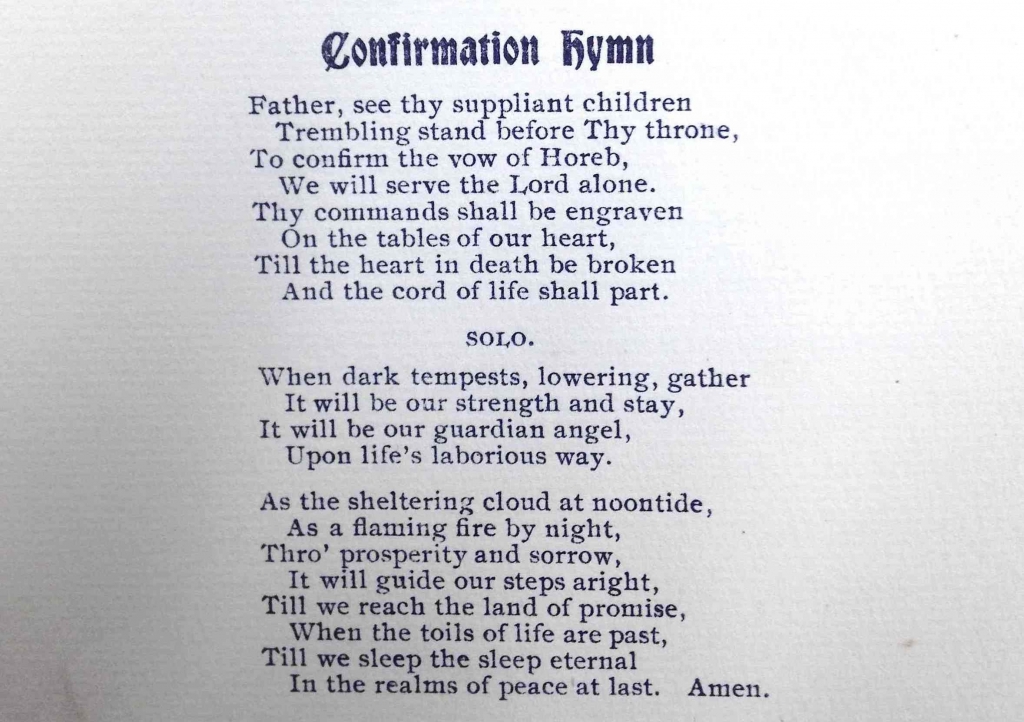The Confirmation Ceremony
One of the objects included in the Time Capsule of Temple De Hirsch was the program from the 1901 Ceremony of Confirmation. The role that confirmation played in the early temple sheds light on the process of religious reform and acculturation that characterized Reform Judaism in Seattle and around the United States.
Before delving into the content of the ceremony itself, it is important to note the centrality of this particular ritual–one with no precedent in traditional Jewish sources. The primary coming of age ritual for Jews was the Bar Mitzvah, a celebration of a young man’s acceptance of the positive commandments of Judaism at age 13. Bar Mitzvah, a term that literally means “son of the commandments,” reflects a tenet in Judaism that all men are required to fulfill the 613 commandments that God asked the Jewish people to follow as part of the covenant between God and his chosen people.
Where did the idea of confirmation come from? We will return to this question after analyzing the program text.
The order of the services provides insights into the meaning of the confirmation service. One notes the similarities to titles now more familiar to christian religious communities. For instance, the prayer leader was not referred to as a “rabbi,” but as a minister. The service does include the traditional practice of reading from the Torah, or Hebrew Bible. However, the reading chosen is quite significant. The central scripture for the service was “the decalogue,” otherwise known as the ten commandments.

A portion of “The Order of Services” page in the 1901 Temple
De Hirsch Ceremony of Confirmation Program
Another note is the recitation of a “Declaration of principles.” The centrality of the decalogue is not completely random. The confirmation service was held in early June, around the time of Shavuot. The connection to Shavuot links the holiday associated with the giving of the Torah at Mt. Sinai with the confirmation service (while Shavuot set the broad theme for the confirmation service, the actual date selected was the first Sunday after the holiday according to the Hebrew calendar.) Confirmation reframed the Jewish holiday of Shavuot from the binding obligation to follow certain ritual actions to a declaration of divine principles that are encapsulated in the Ten commandments. The focus on belief is so central to the confirmation ceremony that the students participated in an examination of their knowledge as part of the ritual.
The aesthetics and order of the service owe a great deal to the desire to shape the new Jewish “congregation along American lines.” The service was shaped around musical performances of classical music–often compositions intended for Christian worship. The structure of this ritual closely resembles that of a graduation ceremony–with a processional, presentation of diplomas, valedictory address, and greetings from specific clubs. The model of membership within the Jewish community was shaped by the American ritual of graduation–a ritual celebrating the mastery over content knowledge presented over a specific curriculum.
The Significance of the Confirmation in American Reform Judaism
The rise of the confirmation demonstrates the influence of protestant definitions of religion on Jewish thought. Confirmation reshaped Jewish theology to fit the expectations of a creedal religious tradition equated religion with theological and ethical commitments. Indeed, confirmation existed as a key coming-of-age moment for Catholics and several protestant denominations (including German Lutherans, the majority religion in the German land that sparked the first Reform communities in the early decades of the nineteenth century.) This program offered a set of religious practices that meshed perfectly with the expectations for the Christian coming of age ceremonies that were popular in the United States. Bar Mitzvah welcomed boys at the age of 13 because the primary responsibility was the fulfillment of proscribed ritual commandments.The confirmation ceremony provided a new ritual that would affirm a commitment to the Jewish tradition within the vocabulary and structure of American religious traditions and graduation celebrations.

